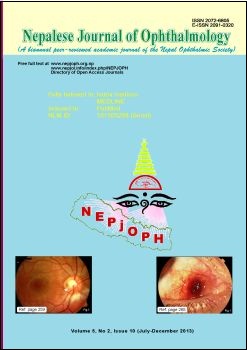Optical coherence tomography in diabetic macular edema: patterns and related risk factors
DOI:
https://doi.org/10.3126/nepjoph.v5i2.8727Keywords:
optical coherence tomography, diabetic macular edema, OCT pattern, diabetic retinopathyAbstract
Introduction: Diabetic Macular Edema (DME) is an important cause of vision loss in diabetic retinopathy. Optical Coherence Tomography (OCT) is a non-invasive modality that produces high-resolution images of retinal layers.
Objective: To evaluate the prevalence of DME patterns and their association with risk factors and visual acuity.
Materials and Methods: In this cross-sectional study, type 2 diabetics with macular edema referred to our center during a ten-month period underwent OCT. Patients with macular edema due to causes other than diabetes and with OCT images of improper quality were excluded from the study. Four distinct patterns were found in the OCT images. A questionnaire including age, sex, duration of diabetes, serum TG and cholesterol, HbA1c, BMI and visual acuity, as well as the findings of OCT images were filled for the subjects.
Results: Eighty-six eyes from 46 patients were evaluated. The most and the least common patterns were sponge-like retinal swelling (SLRS) and posterior hyaloidal traction (PHT) found in 64.0% and 5.8% of the subjects, respectively. A sub-retinal fluid pattern was more common in males (p=0.011) and in patients with serum TG > 200mg/dl (p=0.037). There were significant associations between central foveal (r=0.45, p<0.001), nasal (r=0.35, p=0.001) and temporal (r=0.32, p=0.003) thicknesses with visual acuity. Moreover, the highest thickness (462.4±119.2μm) and also the worst visual acuity (1.0±0.5logMAR) pertained to the cystoid macular edema (CME) pattern.
Conclusion: Our study showed that the most common OCT pattern of DME is the sponge-like retinal swelling, while posterior hyaloidal traction has the lowest prevalence. A higher foveal thickness and a lower visual acuity are seen in the CME pattern.
Nepal J Ophthalmol 2013; 5(10): 190-194
Downloads
Downloads
Published
How to Cite
Issue
Section
License
This license enables reusers to copy and distribute the material in any medium or format in unadapted form only, for noncommercial purposes only, and only so long as attribution is given to the creator.




